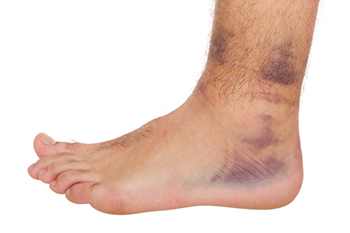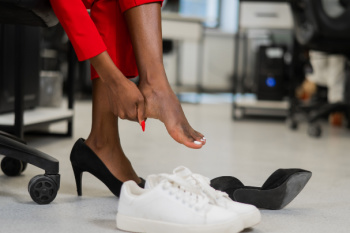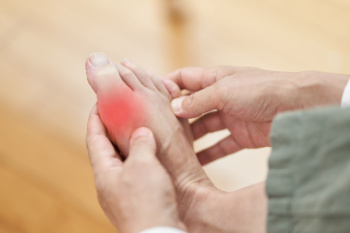Items filtered by date: June 2024
Three Types of Ankle Sprains

Ankle sprains are common injuries classified into three types based on their degree and severity. A first-degree sprain is the mildest form, involving slight stretching or microscopic tearing of the ligament fibers. Symptoms include mild pain, swelling, and stiffness, with little to no instability in the ankle joint. A second-degree sprain is more severe, characterized by partial tearing of the ligament. This type results in moderate pain, swelling, and bruising, with some difficulty bearing weight and noticeable instability in the ankle. The most severe is a third-degree sprain, where the ligament is completely torn. This causes significant pain, swelling, and bruising, in addition to a substantial loss of function and stability in the ankle. Recovery times vary depending on the severity, with mild sprains healing within a few weeks and severe sprains potentially taking several months. If you have suffered a sprained ankle, it is suggested that you consult a podiatrist who can determine what type of sprain you have endured, and offer correct treatment for it.
Ankle sprains are common but need immediate attention. If you need your feet checked, contact one of our podiatrists from Prince William Foot & Ankle Center, PC. Our practitioners can provide the care you need to keep you pain-free and on your feet.
How Does an Ankle Sprain Occur?
Ankle sprains take place when the ligaments in your ankle are torn or stretched beyond their limits. There are multiple ways that the ankle can become injured, including twisting or rolling over onto your ankle, putting undue stress on it, or causing trauma to the ankle itself.
What Are the Symptoms?
- Mild to moderate bruising
- Limited mobility
- Swelling
- Discoloration of the skin (depending on severity)
Preventing a Sprain
- Wearing appropriate shoes for the occasion
- Stretching before exercises and sports
- Knowing your limits
Treatment of a Sprain
Treatment of a sprain depends on the severity. Many times, people are told to rest and remain off their feet completely, while others are given an air cast. If the sprain is very severe, surgery may be required.
If you have suffered an ankle sprain previously, you may want to consider additional support such as a brace and regular exercises to strengthen the ankle.
If you have any questions please feel free to contact our offices located in Gainesville and Dulles, VA . We offer the newest diagnostic and treatment technologies for all your foot and ankle needs.
How Foot Pain Contributes to Falls in Seniors

With age, the risk of falling becomes a significant concern for many seniors. Studies show that foot pain and foot posture have emerged as potential contributors to falling among the elderly. It is believed that seniors experiencing severe foot pain, along with those having flat feet, are more prone to recurrent falls. While not every fall can be attributed to foot issues, multiple falls often correlate with foot pain and posture problems. These factors increase the risk of serious consequences, such as hospitalization and loss of independence. A significant percentage of individuals over 65 experience at least one fall a year, and this number rises even higher for those aged 75 and older. By tackling foot pain and posture issues, seniors may help to reduce the occurrence of falls and enhance their overall quality. If you are grappling with foot pain or concerned about foot posture, it is suggested that you schedule an appointment with a podiatrist to address these problems and reduce the risk of falls.
Preventing falls among the elderly is very important. If you are older and have fallen or fear that you are prone to falling, consult with one of our podiatrists from Prince William Foot & Ankle Center, PC. Our practitioners will assess your condition and provide you with quality advice and care.
Every 11 seconds, an elderly American is being treated in an emergency room for a fall related injury. Falls are the leading cause of head and hip injuries for those 65 and older. Due to decreases in strength, balance, senses, and lack of awareness, elderly persons are very susceptible to falling. Thankfully, there are a number of things older persons can do to prevent falls.
How to Prevent Falls
Some effective methods that older persons can do to prevent falls include:
- Enrolling in strength and balance exercise program to increase balance and strength
- Periodically having your sight and hearing checked
- Discuss any medications you have with a doctor to see if it increases the risk of falling
- Clearing the house of falling hazards and installing devices like grab bars and railings
- Utilizing a walker or cane
- Wearing shoes that provide good support and cushioning
- Talking to family members about falling and increasing awareness
Falling can be a traumatic and embarrassing experience for elderly persons; this can make them less willing to leave the house, and less willing to talk to someone about their fears of falling. Doing such things, however, will increase the likelihood of tripping or losing one’s balance. Knowing the causes of falling and how to prevent them is the best way to mitigate the risk of serious injury.
If you have any questions, please feel free to contact our offices located in Gainesville and Dulles, VA . We offer the newest diagnostic and treatment technologies for all your foot care needs.
Possible Causes of Heel Pain
 Heel pain can stem from various conditions. Plantar fasciitis, the inflammation of the thick band of tissue running along the bottom of the foot, often causes stabbing pain near the heel. Bursitis, an inflammation of the fluid-filled sacs cushioning the heel, can result from repetitive stress. Heel spurs, bony growths on the underside of the heel bone, may develop due to long-term strain on foot muscles and ligaments. A pump bump, or Haglund's deformity, is a bony enlargement on the back of the heel caused by pressure from footwear. Achilles tendonitis is inflammation of the Achilles tendon, typically due to overuse or tight calf muscles. Diagnosing heel pain involves having a physical exam, reviewing medical history, and sometimes undergoing imaging tests, such as X-rays or MRI scans. Treatment options include rest, stretching exercises, orthotics, and anti-inflammatory medications. If you have persistent heel pain, it is suggested that you schedule an appointment with a podiatrist for a proper diagnosis and treatment plan.
Heel pain can stem from various conditions. Plantar fasciitis, the inflammation of the thick band of tissue running along the bottom of the foot, often causes stabbing pain near the heel. Bursitis, an inflammation of the fluid-filled sacs cushioning the heel, can result from repetitive stress. Heel spurs, bony growths on the underside of the heel bone, may develop due to long-term strain on foot muscles and ligaments. A pump bump, or Haglund's deformity, is a bony enlargement on the back of the heel caused by pressure from footwear. Achilles tendonitis is inflammation of the Achilles tendon, typically due to overuse or tight calf muscles. Diagnosing heel pain involves having a physical exam, reviewing medical history, and sometimes undergoing imaging tests, such as X-rays or MRI scans. Treatment options include rest, stretching exercises, orthotics, and anti-inflammatory medications. If you have persistent heel pain, it is suggested that you schedule an appointment with a podiatrist for a proper diagnosis and treatment plan.
Many people suffer from bouts of heel pain. For more information, contact one of our podiatrists of Prince William Foot & Ankle Center, PC. Our practitioners can provide the care you need to keep you pain-free and on your feet.
Causes of Heel Pain
Heel pain is often associated with plantar fasciitis. The plantar fascia is a band of tissues that extends along the bottom of the foot. A rip or tear in this ligament can cause inflammation of the tissue.
Achilles tendonitis is another cause of heel pain. Inflammation of the Achilles tendon will cause pain from fractures and muscle tearing. Lack of flexibility is also another symptom.
Heel spurs are another cause of pain. When the tissues of the plantar fascia undergo a great deal of stress, it can lead to ligament separation from the heel bone, causing heel spurs.
Why Might Heel Pain Occur?
- Wearing ill-fitting shoes
- Wearing non-supportive shoes
- Weight change
- Excessive running
Treatments
Heel pain should be treated as soon as possible for immediate results. Keeping your feet in a stress-free environment will help. If you suffer from Achilles tendonitis or plantar fasciitis, applying ice will reduce the swelling. Stretching before an exercise like running will help the muscles. Using all these tips will help make heel pain a condition of the past.
If you have any questions please contact our offices located in Gainesville and Dulles, VA . We offer the newest diagnostic and treatment technologies for all your foot and ankle needs.
It's Time for Beautiful Feet
Symptoms and Management of Early Onset Gout

Early onset gout, a form of arthritis, can be a debilitating condition that disrupts daily life and impacts overall well-being. Gout typically manifests as sudden and intense pain, swelling, and tenderness in the joints, often affecting the big toe initially. This inflammatory response occurs due to the buildup of uric acid crystals in the joints, resulting from an imbalance in the body's production and excretion of uric acid. While gout is commonly associated with older age and certain lifestyle factors, like diet and alcohol consumption, it can also develop in younger individuals, often due to genetic predisposition or underlying health conditions. Managing early onset gout involves a multifaceted approach, including medication to alleviate symptoms, dietary modifications to reduce purine-rich foods, and lifestyle changes to maintain a healthy weight and minimize alcohol intake. Gout typically affects the big toe, and can cause severe pain and discomfort. If you have been afflicted with gout, it is suggested that you seek prompt attention from a podiatrist who can offer you relief and prevention methods.
Gout is a foot condition that requires certain treatment and care. If you are seeking treatment, contact one of our podiatrists from Prince William Foot & Ankle Center, PC. Our practitioners will treat your foot and ankle needs.
What Is Gout?
Gout is a type of arthritis caused by a buildup of uric acid in the bloodstream. It often develops in the foot, especially the big toe area, although it can manifest in other parts of the body as well. Gout can make walking and standing very painful and is especially common in diabetics and the obese.
People typically get gout because of a poor diet. Genetic predisposition is also a factor. The children of parents who have had gout frequently have a chance of developing it themselves.
Gout can easily be identified by redness and inflammation of the big toe and the surrounding areas of the foot. Other symptoms include extreme fatigue, joint pain, and running high fevers. Sometimes corticosteroid drugs can be prescribed to treat gout, but the best way to combat this disease is to get more exercise and eat a better diet.
If you have any questions please feel free to contact our offices located in Gainesville and Dulles, VA . We offer the newest diagnostic and treatment technologies for all your foot and ankle needs.


